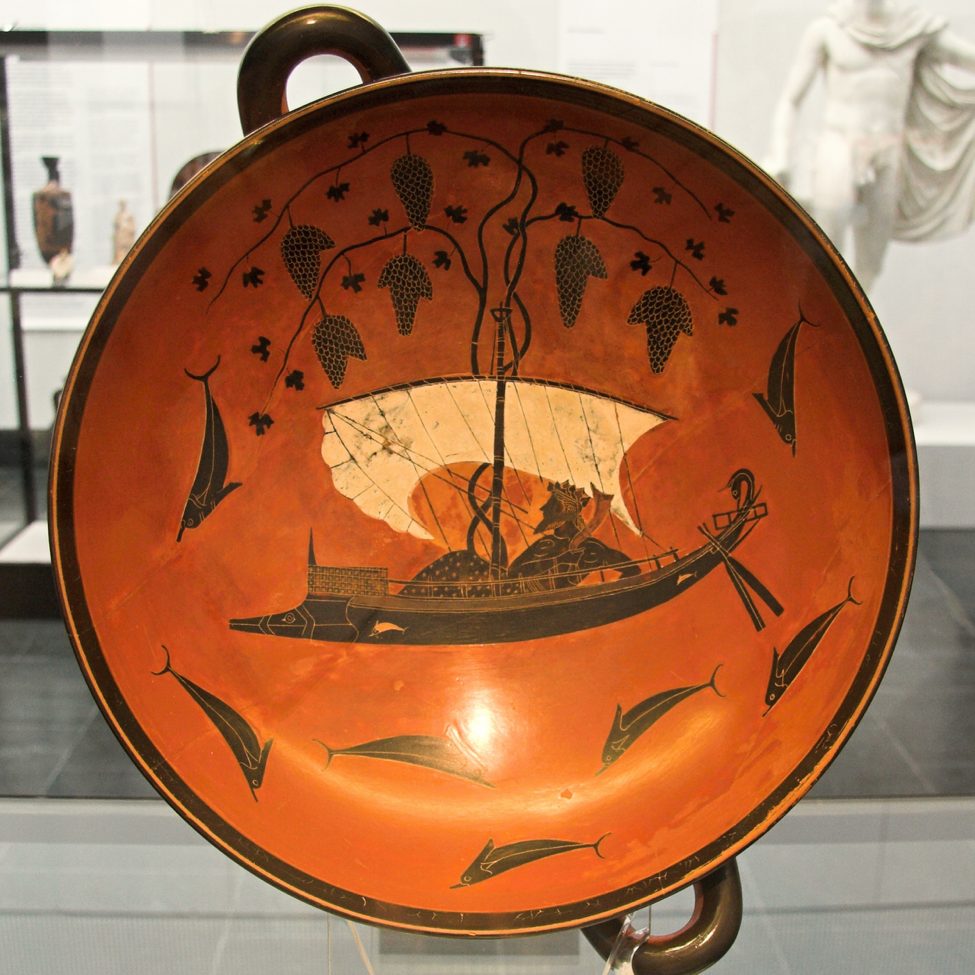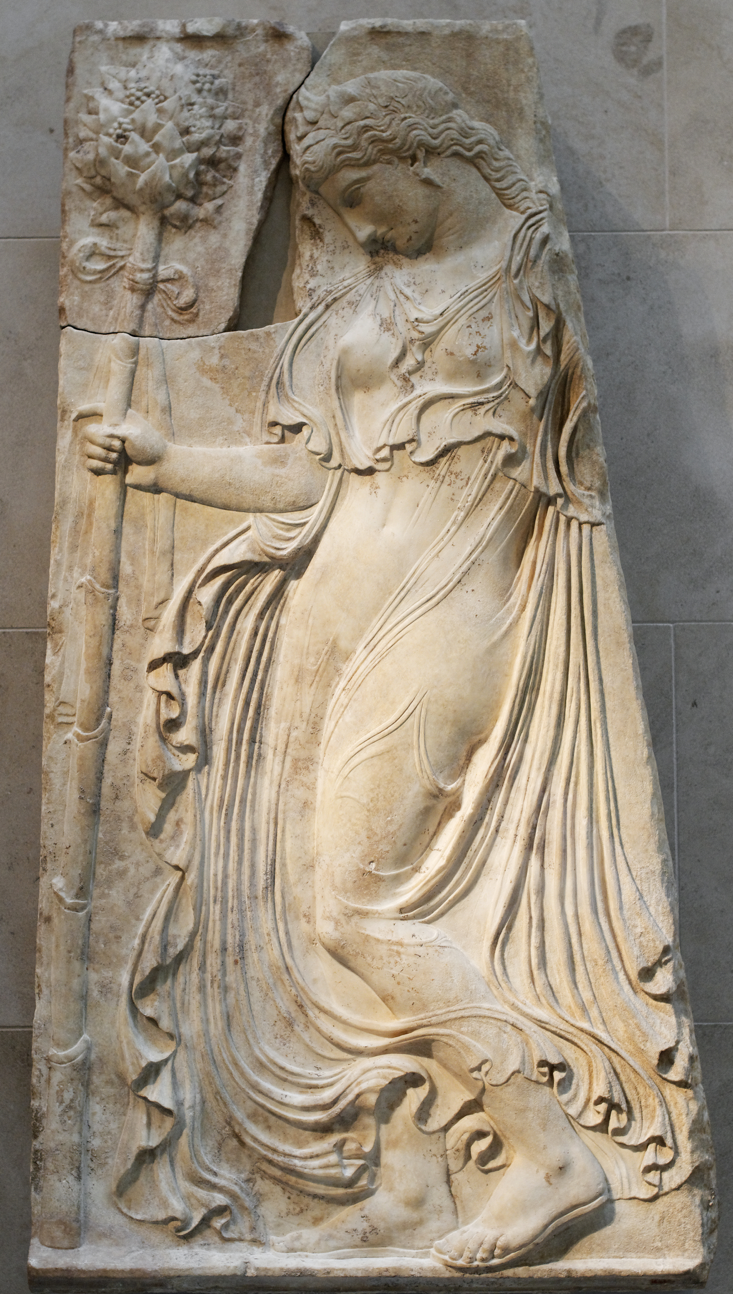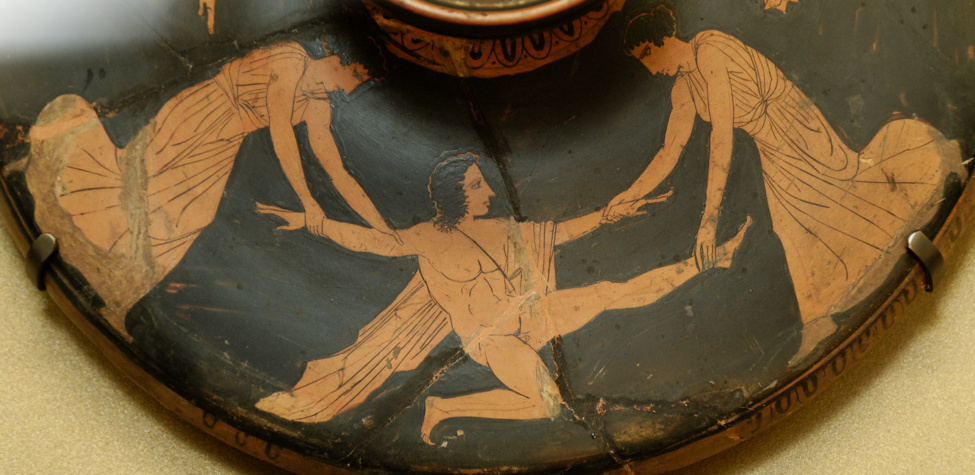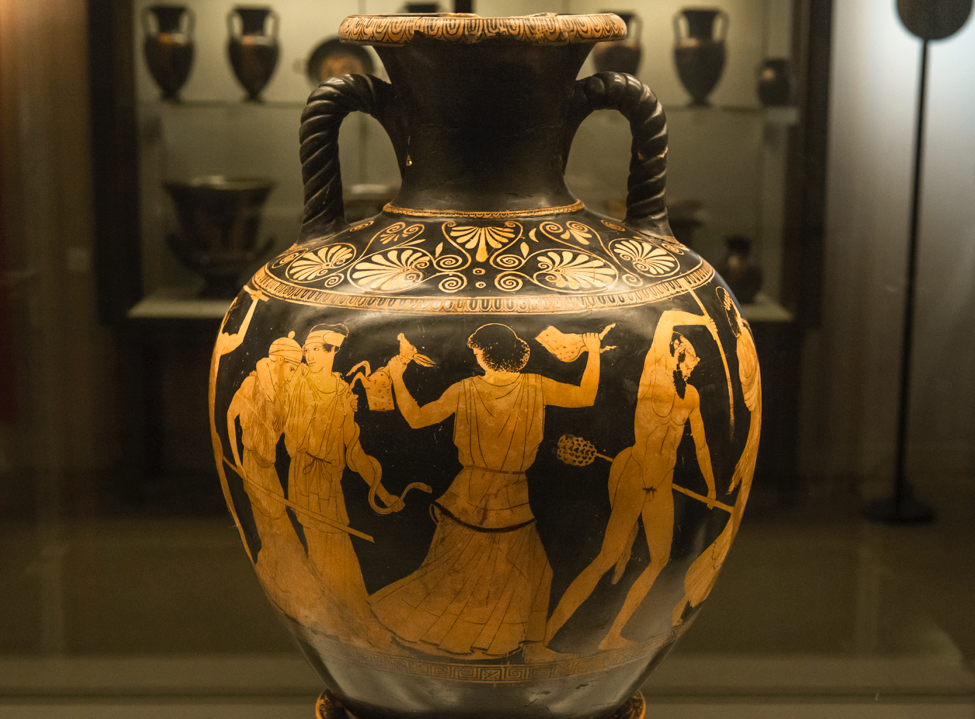1.12: Bacchus
- Page ID
- 15349
\( \newcommand{\vecs}[1]{\overset { \scriptstyle \rightharpoonup} {\mathbf{#1}} } \)
\( \newcommand{\vecd}[1]{\overset{-\!-\!\rightharpoonup}{\vphantom{a}\smash {#1}}} \)
\( \newcommand{\dsum}{\displaystyle\sum\limits} \)
\( \newcommand{\dint}{\displaystyle\int\limits} \)
\( \newcommand{\dlim}{\displaystyle\lim\limits} \)
\( \newcommand{\id}{\mathrm{id}}\) \( \newcommand{\Span}{\mathrm{span}}\)
( \newcommand{\kernel}{\mathrm{null}\,}\) \( \newcommand{\range}{\mathrm{range}\,}\)
\( \newcommand{\RealPart}{\mathrm{Re}}\) \( \newcommand{\ImaginaryPart}{\mathrm{Im}}\)
\( \newcommand{\Argument}{\mathrm{Arg}}\) \( \newcommand{\norm}[1]{\| #1 \|}\)
\( \newcommand{\inner}[2]{\langle #1, #2 \rangle}\)
\( \newcommand{\Span}{\mathrm{span}}\)
\( \newcommand{\id}{\mathrm{id}}\)
\( \newcommand{\Span}{\mathrm{span}}\)
\( \newcommand{\kernel}{\mathrm{null}\,}\)
\( \newcommand{\range}{\mathrm{range}\,}\)
\( \newcommand{\RealPart}{\mathrm{Re}}\)
\( \newcommand{\ImaginaryPart}{\mathrm{Im}}\)
\( \newcommand{\Argument}{\mathrm{Arg}}\)
\( \newcommand{\norm}[1]{\| #1 \|}\)
\( \newcommand{\inner}[2]{\langle #1, #2 \rangle}\)
\( \newcommand{\Span}{\mathrm{span}}\) \( \newcommand{\AA}{\unicode[.8,0]{x212B}}\)
\( \newcommand{\vectorA}[1]{\vec{#1}} % arrow\)
\( \newcommand{\vectorAt}[1]{\vec{\text{#1}}} % arrow\)
\( \newcommand{\vectorB}[1]{\overset { \scriptstyle \rightharpoonup} {\mathbf{#1}} } \)
\( \newcommand{\vectorC}[1]{\textbf{#1}} \)
\( \newcommand{\vectorD}[1]{\overrightarrow{#1}} \)
\( \newcommand{\vectorDt}[1]{\overrightarrow{\text{#1}}} \)
\( \newcommand{\vectE}[1]{\overset{-\!-\!\rightharpoonup}{\vphantom{a}\smash{\mathbf {#1}}}} \)
\( \newcommand{\vecs}[1]{\overset { \scriptstyle \rightharpoonup} {\mathbf{#1}} } \)
\( \newcommand{\vecd}[1]{\overset{-\!-\!\rightharpoonup}{\vphantom{a}\smash {#1}}} \)
\(\newcommand{\avec}{\mathbf a}\) \(\newcommand{\bvec}{\mathbf b}\) \(\newcommand{\cvec}{\mathbf c}\) \(\newcommand{\dvec}{\mathbf d}\) \(\newcommand{\dtil}{\widetilde{\mathbf d}}\) \(\newcommand{\evec}{\mathbf e}\) \(\newcommand{\fvec}{\mathbf f}\) \(\newcommand{\nvec}{\mathbf n}\) \(\newcommand{\pvec}{\mathbf p}\) \(\newcommand{\qvec}{\mathbf q}\) \(\newcommand{\svec}{\mathbf s}\) \(\newcommand{\tvec}{\mathbf t}\) \(\newcommand{\uvec}{\mathbf u}\) \(\newcommand{\vvec}{\mathbf v}\) \(\newcommand{\wvec}{\mathbf w}\) \(\newcommand{\xvec}{\mathbf x}\) \(\newcommand{\yvec}{\mathbf y}\) \(\newcommand{\zvec}{\mathbf z}\) \(\newcommand{\rvec}{\mathbf r}\) \(\newcommand{\mvec}{\mathbf m}\) \(\newcommand{\zerovec}{\mathbf 0}\) \(\newcommand{\onevec}{\mathbf 1}\) \(\newcommand{\real}{\mathbb R}\) \(\newcommand{\twovec}[2]{\left[\begin{array}{r}#1 \\ #2 \end{array}\right]}\) \(\newcommand{\ctwovec}[2]{\left[\begin{array}{c}#1 \\ #2 \end{array}\right]}\) \(\newcommand{\threevec}[3]{\left[\begin{array}{r}#1 \\ #2 \\ #3 \end{array}\right]}\) \(\newcommand{\cthreevec}[3]{\left[\begin{array}{c}#1 \\ #2 \\ #3 \end{array}\right]}\) \(\newcommand{\fourvec}[4]{\left[\begin{array}{r}#1 \\ #2 \\ #3 \\ #4 \end{array}\right]}\) \(\newcommand{\cfourvec}[4]{\left[\begin{array}{c}#1 \\ #2 \\ #3 \\ #4 \end{array}\right]}\) \(\newcommand{\fivevec}[5]{\left[\begin{array}{r}#1 \\ #2 \\ #3 \\ #4 \\ #5 \\ \end{array}\right]}\) \(\newcommand{\cfivevec}[5]{\left[\begin{array}{c}#1 \\ #2 \\ #3 \\ #4 \\ #5 \\ \end{array}\right]}\) \(\newcommand{\mattwo}[4]{\left[\begin{array}{rr}#1 \amp #2 \\ #3 \amp #4 \\ \end{array}\right]}\) \(\newcommand{\laspan}[1]{\text{Span}\{#1\}}\) \(\newcommand{\bcal}{\cal B}\) \(\newcommand{\ccal}{\cal C}\) \(\newcommand{\scal}{\cal S}\) \(\newcommand{\wcal}{\cal W}\) \(\newcommand{\ecal}{\cal E}\) \(\newcommand{\coords}[2]{\left\{#1\right\}_{#2}}\) \(\newcommand{\gray}[1]{\color{gray}{#1}}\) \(\newcommand{\lgray}[1]{\color{lightgray}{#1}}\) \(\newcommand{\rank}{\operatorname{rank}}\) \(\newcommand{\row}{\text{Row}}\) \(\newcommand{\col}{\text{Col}}\) \(\renewcommand{\row}{\text{Row}}\) \(\newcommand{\nul}{\text{Nul}}\) \(\newcommand{\var}{\text{Var}}\) \(\newcommand{\corr}{\text{corr}}\) \(\newcommand{\len}[1]{\left|#1\right|}\) \(\newcommand{\bbar}{\overline{\bvec}}\) \(\newcommand{\bhat}{\widehat{\bvec}}\) \(\newcommand{\bperp}{\bvec^\perp}\) \(\newcommand{\xhat}{\widehat{\xvec}}\) \(\newcommand{\vhat}{\widehat{\vvec}}\) \(\newcommand{\uhat}{\widehat{\uvec}}\) \(\newcommand{\what}{\widehat{\wvec}}\) \(\newcommand{\Sighat}{\widehat{\Sigma}}\) \(\newcommand{\lt}{<}\) \(\newcommand{\gt}{>}\) \(\newcommand{\amp}{&}\) \(\definecolor{fillinmathshade}{gray}{0.9}\)Roman name: Bacchus, Liber Pater (Free Father)
Epithets: Twice-Born, Bromios (Thunderer)
Symbols: thyrsus (staff carried by maenads), maenads/bacchae/bacchants (female followers), vines, satyrs, wine, drinking cup, bull, panther, snakes
Function: God of wine and drunkenness
The Birth of Dionysus
Dionysus was the son of Zeus and the mortal woman Semele, who was the daughter of Cadmus, King of Thebes [see Thebae on map]. When Hera learned that Semele was pregnant with her husband’s child, she disguised herself as Semele’s nurse and convinced the girl she should demand that Zeus show himself to her as he did to his wife, but first she should make him swear to meet any demand she might make. Semele did so and Zeus was forced to comply. Unfortunately, it seems that Zeus showed himself to Hera in the form of a lightning bolt. So, Semele was struck by Zeus’ lightning and died in a blaze. Hermes rescued the unborn baby from Semele’s womb and the child was sewn into Zeus’ thigh where he stayed for the rest of the pregnancy. When he was ready to be born, Dionysus was delivered from his father’s thigh, which explains Dionysus’ epithet, Twice-Born. Hermes spirited the boy away to live with his aunt, Ino (one of his mother’s sisters). Ino and her husband, Athamas, raised Dionysus as a girl to try to hide him from Hera’s wrath, but Hera was not fooled and caused Ino to go mad. After several mishaps, Ino jumped into the sea, where she became the goddess, Leucothea.
Dionysus and the Tyrrhenian Pirates
When Dionysus was still a young boy, he found himself in need of passage to the island of Naxos [map]. He asked some Tyrrhenian (Etruscan) pirates for a ride and the pirates agreed, but they actually planned to kidnap him, believing that he was the son of a wealthy family who would pay a hefty ransom for their child. While at sea, the crew tried to tie him up, but the bonds fell away of their own accord. At this point the helmsman recognized that this was no ordinary boy and tried to prevent any harm coming to Dionysus, but the captain ignored the helmsman’s warning and told the sailors to hold on to the boy. Suddenly, wine began to flow all over the ship; vines began to grow from the sails and ivy began to twine around the mast. Then Dionysus turned into a lion and a bear appeared on the deck. The lion seized the captain and began to tear him apart, and the sailors jumped into the sea, turning into dolphins. Dionysus, now back in human form, prevented the helmsman from following his comrades into the sea and told him that his aid would be rewarded and no harm would come to him.

Dionysus and the Tyrrhenian pirates on a kylix in the Staatliche Antikensammlungen in Munich
Dionysus and Phrygia
Hera still hated Dionysus and she drove him mad, causing him to run away and wander around the world until he came to Phrygia (in what is now central Turkey). Here he met Cybele, a Phrygian mother goddess whose worship had been accepted by the Greeks. Cybele cured him of his madness and Dionysus established his cult and rites of worship. Dionysus’ rites were similar to those of Cybele, and they involved drinking, wild dancing, playing the tambourine, and a feeling of ecstasy, or divine possession. (“Ecstasy” is from a Greek word, meaning “to stand outside oneself.”) Dionysus also gained a group of female followers, called maenads (or bacchae or bacchants), who followed him around, singing, dancing, drinking, and playing the tambourine. Maenads (their name means “mad women”) are usually shown in a state of ecstasy. Dionysus is also usually accompanied by satyrs. Satyrs are men with goat’s legs, horse’s tails, and a vigorous appetite for wine and sex. They are often shown with huge erections. Dionysus then set his sights on establishing his worship in his homeland, so he traveled back to Greece.

A dancing maenad found in the Metropolitan Museum of Art in New York City
God or Mortal?
Dionysus’ status as a god was always an issue. There is an informal rule that, if you have one divine parent and one human parent, then you are a human (usually a hero) and not a god. Examples include Achilles, Theseus, Helen of Troy, Sarpedon, Aeneas, and many others. But there were two exceptions to this rule. Heracles (Hercules), who became a god and was taken up to Mt. Olympus upon his death, and Dionysus. Dionysus insisted that he was always a god (maybe because he was born from Zeus’ thigh), and stories like the Tyrrhenian Pirates (told above) seem to confirm this. But no one believed him because his mother was a mortal. So, when Dionysus traveled back to Greece to establish his rites, he had trouble convincing people that he really was a god.
Resistance Myths
There are several Resistance Myths connected with Dionysus. Resistance Myths are stories about men or women who try to resist the worship of a particular god or goddess. In these Resistance Myths, the attempt of the mortal to resist the god’s worship always ends badly: the god or goddess destroys the resisting human and succeeds in establishing his or her worship. There are a number of Resistance Myths attached to Dionysus, more than for any other god or goddess. Mortals resisted Dionysus’ worship partly because they did not believe he was a god, and partly because his worship involved drinking, drunkenness, open sexual expression, and the loss of one’s reason or self-control.

A maenad and an ithyphallic satyr on a kylix in the Staatliche Antikensammlungen in Munich
The most famous Resistance Myth connected with Dionysus occurred in his city of origin, Thebes, with his cousin Pentheus. After Semele died, her sisters, most notably Agave, spread the rumor that Semele had lied about the paternity of her child and Zeus had punished her for it with his thunderbolt. As a result, no one in Thebes believed that Dionysus was divine. The years passed and, because Cadmus, the king of Thebes, had only daughters, when he decided to retire, he gave the throne to Agave’s son, Pentheus. He was a very young man, perhaps only about twenty or twenty-one when he became King of Thebes. Dionysus came to Thebes to introduce his worship to his homeland, but Pentheus forbade any of the Theban women to worship him. Pentheus probably did this because he did not believe Dionysus was a god, but he also seems to have been a straight and narrow kind of guy, who was disgusted by Dionysus’ rituals. A third reason may have been that Pentheus felt that this was a good opportunity to establish his authority. At any rate, Pentheus did not allow the women of Thebes to worship Dionysus. Dionysus, however, caused all the women of Thebes to go mad and run away from home. They all left their fathers and husbands and ran away to Mount Cithaeron, where they became maenads, singing, dancing, drinking wine, and worshipping Dionysus. Pentheus was upset at this behavior and tried to imprison Dionysus, who had disguised himself as a priest of Dionysus. The god easily escaped from prison, of course, and he took a terrible revenge upon Pentheus, which is depicted in Euripides’ play, The Bacchae.

Agave and Ino tearing apart Pentheus on a lekanis found in the Louvre
Midas
Dionysus extensively traveled around the world. While he was traveling to India, one of his older satyrs, Silenus (when referred to in the plural, sileni, they are a group of older and prophetic satyrs, and Silenus is usually considered their leader), wandered away from the group and (as he was a little drunk) he fell into a deep sleep. While he was sleeping, he was captured by a group of Phrygians, who sent Silenus to their king, Midas. Midas cared for Silenus until Dionysus came to collect him. Dionysus was grateful and offered Midas any wish he desired as thanks. Midas asked for the ability to turn anything he touched into gold and being unable to dissuade Midas from this wish, Dionysus granted it. Midas was initially thrilled, but before too long it became apparent that he could not eat or drink because anything he tried to place in his mouth turned to gold. Midas begged Dionysus to take the gift back, but once a god gives a gift, it cannot be taken back. However, Dionysus was able to help Midas and told Midas to bathe in Pactolus river and his gift would transfer to the river (this myth explains why there is so much gold in the river).
Dionysus and Ariadne
When Ariadne was abandoned by Theseus on Naxos, Dionysus found her there and married her [see Theseus]. She gave birth to several sons and Hesiod says that Zeus granted her immortality so she could live with her husband. Some scholars believe that Ariadne originated as a Cretan goddess who was downgraded to a mortal when the Greeks appropriated the story.

Bacchus and Ariadne by Titian (1520-1523) in the National Gallery in London
The Origin of Dionysus
Scholars are divided on the origins of Dionysus. He seems to be a Mycenaean god because his name is found in a Mycenaean inscription, but his myths and rites (called orgia) are very eastern. His rituals involved intoxication and a loss of control of the body (called ecstasy, with ec- meaning “out” and -stasy meaning “stand”; together they mean “to stand outside of oneself and allow Dionysus to possess the body”) and his sacrifices were performed by tearing the animal limb from limb (this process is called “sparagmos”). Sometimes Dionysus’ worshippers would eat the sacrificial victim raw (this is called “homophagia”). These strange rituals made the Greek traditionalists uneasy because they had that foreign flair and flew in the face of the Greek ideals of self-control and moderation (sophrosyne).
At some point the theater was connected to Dionysus, but it is unclear how that relationship began. In Athens, the City Dionysia, a festival to Dionysus, became the premier competition for playwrights to show off their work and for Athens to show off their cultural achievements to travelers coming through the city. Dionysus may have been connected through his ability to alter perception, much like theater did, and the addition of the art form to the festival made the proceedings more Greek in nature.

A maenad performing ritual “sparagmos” on a vase found in the Cabinet des Médailles in Paris

